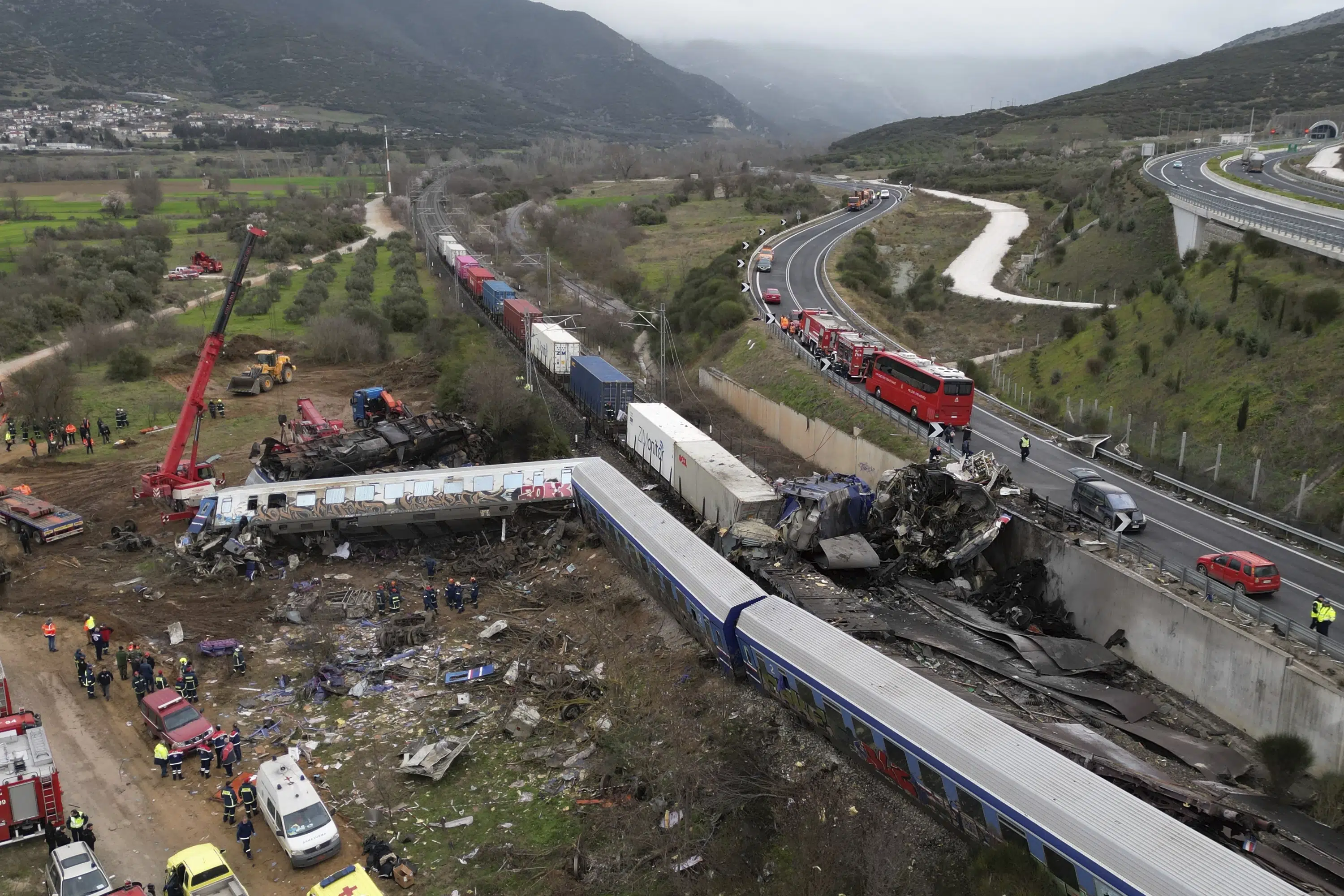This post may refer to COVID-19
To access official information about the coronavirus, access CDC - Centers for Disease Control and Prevention.

apnews.com
Head-on train crash in Greece kills 36, injures at least 85
TEMPE, Greece (AP) — A head-on collision between a passenger train and a freight train flattened carriages, killed at least 36 people and injured some 85, Greek officials said Wednesday, with the death toll expected to rise.
International
TEMPE, Greece (AP) — A head-on collision between a passenger train and a freight train flattened carriages, killed at least 36 people and injured some 85, Greek officials said Wednesday, with the death toll expected to rise.
The cause of the crash was not immediately clear, but the stationmaster in the nearby city of Larissa was arrested Wednesday. The police did not release his name. Another two people have been detained for questioning.
Before dawn the next day, rescuers searched through smoking wreckage for survivors. What appeared to be the third carriage lay atop the twisted remains of the first two.
It’s unclear at what speed the two trains were travelling when they ran into each other just before midnight Tuesday, but state broadcaster ERT quoted rescuers as saying that some victims’ bodies were found 30-40 meters (100-130 feet) from the impact site. Multiple cars derailed and at least three burst into flames in the crash near the town of Tempe, about 380 kilometers (235 miles) north of Athens.
Survivors said the impact threw several passengers through the windows of train cars. They said others fought to free themselves after the passenger train buckled, slamming into a field near a gorge.
Many of the 350 people aboard the passenger train were students returning from Greece’s raucous Carnival, officials said. This year was the first time the three-day festival, which precedes Lent, was celebrated in full since the start of the pandemic in 2020.
Visiting the accident scene, Greek Prime Minister Kyriakos Mitsotakis said that the government must help the injured recover and identify the dead.
“I can guarantee one thing: We will find out the causes of this tragedy and we will do all that’s in our power so that something like this never happens again,” Mitsotakis said.
On Wednesday, the government declared three days of national mourning, while flags flew at half-staff outside all European Commission buildings in Brussels.
After sunrise, rescuers turned to cranes and other heavy machinery to start moving large pieces of the trains, revealing more bodies and dismembered remains. Officials said the army had been contacted to assist.
Rescuer Lazaros Sarianidis told state broadcaster ERT that crews were “very carefully” trying to disentangle steel, sheet metal and other material that was twisted together by the crash. “It will take a long time,” said Sarianidis.
Costas Agorastos, the regional governor of the Thessaly area, told Greece’s Skai Television that the two trains collided head on at high speed.
“Carriage one and two no longer exist, and the third has derailed,” he said.
The trains crashed just before the Vale of Tempe, a gorge that separates the regions of Thessaly and Macedonia.
“There were many big pieces of steel,” said Vassilis Polyzos, a local resident who said he was one of the first people on the scene. “The trains were completely destroyed, both passenger and freight trains.”
He said dazed and disoriented people were escaping out of the train’s rear cars as he arrived.
“People, naturally, were scared — very scared,” he said. “They were looking around, searching; they didn’t know where they were.”
Eight rail employees were among those killed in the crash, including the two drivers of the freight train and the two drivers of the passenger train, according to Greek Railroad Workers Union President Yannis Nitsas.
Greece’s firefighting service said some 66 people were hospitalized, including six in intensive care.
“The evacuation process is ongoing and is being carried out under very difficult conditions due to the severity of the collision between the two trains,” said fire service spokesperson Vassilis Varthakoyiannis.
More than 200 people who were unharmed in the crash or suffered minor injuries were transported by bus to Thessaloniki, 130 kilometers (80 miles) to the north. Police took their names as they arrived, in an effort to track anyone who may be missing.
Barely able to hold back tears, Greece’s Transport Minister Kostas Karamanlis told reporters at the crash site that authorities would investigate “in all seriousness and complete transparency” the causes of the crash.
“We will do everything to investigate the causes and won’t leave anything to be swept under the carpet,” Karamanlis said.
A teenage survivor who did not give his name to reporters said that just before the crash he felt a strong braking and saw sparks — then there was a sudden stop.
“Our carriage didn’t derail, but the ones in front did and were smashed,” he said, visibly shaken.
He added that the first car caught fire and that he used a bag to break the window of his car, the fourth, and escape.
Rail operator Hellenic Train said the northbound passenger train to Thessaloniki, Greece’s second-largest city, had about 350 passengers on board.
Hellenic Train is operated by Italy’s FS Group, which runs rail services in several European countries.
___
Patrick Quinn and David Rising contributed to this story from Bangkok. Gatopoulos reported from Athens.
























































